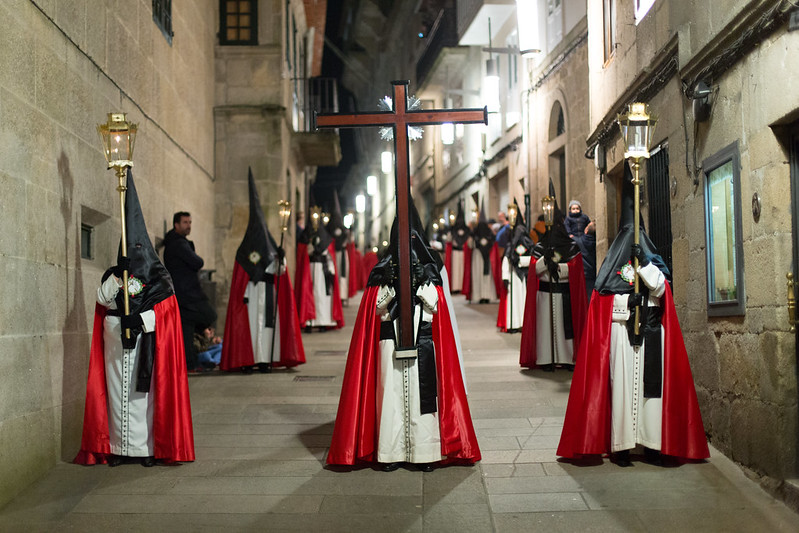Semana Santa
Faith Walking on Flower-Carpeted Paths
2026/03/28 - 2026/04/04
Every spring, Mexico's cobblestone streets transform into living altars. Semana Santa (Holy Week) is a festival blending medieval religious processions with indigenous traditions, inviting participants on a week-long soul-stirring journey through the senses. From Taxco's awe-inspiring penitent processions to San Miguel de Allende's chamomile petal carpets, this festival reveals Mexico's soul through sacred traditions.
Main Highlights
Penitent Processions
At dusk, hooded "penitentes" carry life-sized crucifix figures through the streets. In Taxco, three religious groups lead: "Los Ánimas" bound by candle-wax chains, "Los Enclurados" carrying cactus bundles, and "Los Flagelantes" exposing backs scarred by self-flagellation. The 18th-century church walls echo with iron shackles as beeswax and orange blossom aromas create an intense spiritual atmosphere.
Living Bible Scenes
San Miguel de Allende witnesses all-night processions carrying 200-year-old religious statues from Atotonilco. Families spend 12+ hours creating "alfombras" - sacred carpets of dyed sawdust, marigolds, and fragrant chamomile petals. Each footstep releases chamomile's crisp fragrance, creating the sensation of walking a divine path.
Night of the Virgin
In Taxco, 33 Virgin Mary statues sway on white-veiled women's shoulders through silver-filled streets. Colonial silver-leaf walls reflect votive candles, transforming alleys into amber rivers of light. Vendors sell "Algodón Purgador" - cloud-like cotton candy in purple paper that reveals snow-white purity when unwrapped. Beeswax's sweet aroma mingles with dancing orange petals as silver filigree scatters light like divine confetti.
Traditional Flavors of Mexican Holy Week
Hibiscus-infused "Jamaica" flows from flower-decorated stalls. "Pambazo" sandwiches glisten with guajillo chili sauce, their crisp shells spilling chorizo-potato fillings. Post-procession crowds devour "Gorditas" - thick corn cakes stuffed with zucchini blossoms. "Capirotada" bread pudding layers cinnamon-scented history, with raisins symbolizing Christ's crucifixion wounds.
Cultural & Historical Background
Semana Santa's roots trace to 16th-century Spanish evangelization, merging with indigenous harvest rituals to become Mexico's unique religious tapestry. Traditions like passion plays, palm crosses, and flower altars intertwine with native symbols, creating regional variations across Mexico.
The holy week spans Palm Sunday to Easter Sunday. Towns host passion plays where participants don traditional dress, carrying candles and crosses. Mexico City's Iztapalapa district draws 2 million spectators to its 4,000-actor passion play, while Taxco's penitentes continue medieval Spanish self-flagellation practices as acts of faith.
"Burning of Judas" effigies on Holy Saturday merges Spanish traditions with Mexican satire. Local beeswax candle-making and centuries-old icon restoration techniques highlight artisanal heritage preserved through these rituals.
Participant Voices
"As a photographer, I followed barefoot Enclurados dragging 100kg cactus bundles through midnight streets. Even when rope sandals left blood on stones, they refused water, whispering 'This pain connects to Christ's journey.' The air, thick with sweat and copal incense, created sacred space."
Fun Facts
- Taxco's 287kg crucifix requires 36 bearers training year-round
- Atotonilco's 18th-century murals hide indigenous cornstalk crosses
- Processional candles with church-hive beeswax burn 40% longer than paraffin
- Thursday's "Seven Churches Pilgrimage" birthed Mexico's pub crawl culture
Festival Dates
Semana Santa follows lunar calculations.
The event schedule is subject to change. Please check the official website for the most up-to-date information.
Information
| Name | Semana Santa |
| Country | Mexico |
| Area | San Miguel de Allende |
| Date | 2026/03/28 - 2026/04/04 |
| Link |
Upcoming Festivals
Whirling Dervishes Festival Turkey
A Mesmerizing Dance of Divine Love
2025/12/06Mevlana Celaleddin Rumi Commemoration Ceremony ( Şeb-i Arus ) Turkey
A Whirling Journey to Divine Love
2025/12/10Dia de la Virgen de Guadalupe Mexico
A Festival Weaving Faith, Fervor, and Mexican Identity
2025/12/11L'Escalade Switzerland
Geneva’s Grand Winter Festival of Courage, Chocolate, and Community
2025/12/12Umkhosi Wokweshwama South Africa
The Zulu First Fruits Festival—A Sacred Celebration of Land, Ancestors, and Renewal
2025/12/12Lucia Festival (St. Lucia's Day) Sweden
A Festival of Light Illuminating the Nordic Darkness
2025/12/15Las Posadas Mexico
The Luminous Quest for Sacred Shelter
2025/12/22Noche de Rabanos (Night of the Radishes) Mexico
A celebration blending art, farming heritage, and cultural traditions
2025/12/23Chant of the Sybil on Majorca Spain
A Medieval Prophecy Echoes Through Majorcan Christmas
2025/12/23‘Hatajo de Negritos’ and the ‘Hatajo de Pallitas’ Peru
A Christmas Festival of Rhythm, Faith, and Afro-Andean Heritage in Peru’s Ica Region

